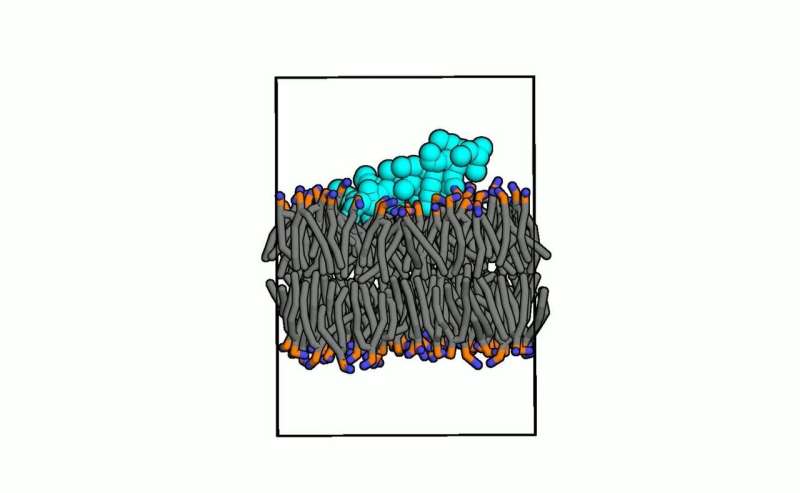This article has been reviewed according to Science X's editorial process and policies. Editors have highlighted the following attributes while ensuring the content's credibility:
fact-checked
trusted source
proofread
Researcher creates algorithm to aid in discovery of new medicines

Ph.D. candidate Jeroen Methorst has developed a computer system that helps researchers find the protein they need to create new medicines. "Our whole group is now using this program," says Methorst. He will defend his Ph.D. thesis on April 2.
Methorst is a nanobiologist and biophysicist, but he didn't find himself very handy in the lab. He taught himself programming, which that turned out to be his forte. "My supervisor, Jelger Risselada, asked if I was up for taking a risk and developing something that could fail, but might also turn out very well."
Methorst completed his Ph.D. at the Leiden Institute of Chemical Research on a computer strategy that the scientific community is likely to find very useful. For instance, colleague Niek van Hilten sought a protein capable of detecting and destroying many types of viruses. He achieved this using the strategy developed by Methorst.
The system knows enough about physics
"Niek's research started with the idea of developing a small protein, composed of twenty amino acids. It had to be able to recognize and break apart the strongly curved membrane of a small virus sphere," says Methorst. His system knows enough about physics to assess whether a molecule can do this.
It can also virtually simulate evolution to propose a suitable molecule. "You put in that you want a protein composed of 20 amino acids, and what it needs to do. A computer program starts with a few hundred randomly generated protein molecules, each twenty amino acids in size."
An evolutionary algorithm allows the selection to crossbreed
Another program evaluates these molecules based on physics: which 10 or 20 molecules are the best at recognizing and breaking apart curved membranes? This selection is then fed back into the evolutionary algorithm. This algorithm virtually breeds them together, akin to natural selection. The molecules essentially have offspring.
Like in nature, these offspring resemble their parents but are also different. The selection program then chooses the best ones and feeds them back into the evolution algorithm. This process continues for about 20 or 30 generations, until the researchers are satisfied.
Whether the researchers can be satisfied is made clear to them by a simulation video generated by Methorst's strategy. "The program that selects the best molecules does so by virtually testing all the molecules in simulations." The researchers can view a sample of these simulations and stop the system when they are satisfied.
Niek van Hilten, who was searching for an effective virus killer, stopped after about 25 generations. The subsequent generation didn't improve upon the previous one. In a German lab was found that the molecule was indeed capable of recognizing and destroying viruses in reality.
Sometimes things go wrong: The ingenious evolutionary biodynamic system also found molecules that could attract cholesterol. "Unfortunately, these molecules also strongly attracted each other in the lab. That clustering is undesirable." Such mishaps can occur because the system's knowledge doesn't encompass all of physics. "It lacks quantum mechanics, as that would slow down the selection program," says Methorst.
To set Methorst's system in motion, a vast amount of computing power is required. "That's the bottleneck because supercomputers are scarce. You have to apply for one, much like you would for a research grant."
The key to completing the system
The next step is making the enormous amount of simulation data usable for other researchers. Student Nino Verwei is working on a self-learning algorithm that predicts how a molecule should be structured to perform its function. "That's the key to completing my system. It saves a lot of computing power, and the likelihood of the molecule working in the lab increases."
The algorithm is trained using data from numerous simulations from Methorst's selection program. Based on this knowledge, the algorithm predicts how well a molecule that hasn't been tested in the lab will work. "We've now launched a web server where AI predicts how well a molecule works." Anyone can use it.
So the gamble that Methorst took turned out quite positively. "Our whole group is now using my programs." He himself will remain involved as a postdoc for the time being. "Because I wrote the programs, I know exactly how to work with them."
Related research is also published in the Journal of Chemical Theory and Computation.
More information: Jeroen Methorst et al, When Data Are Lacking: Physics-Based Inverse Design of Biopolymers Interacting with Complex, Fluid Phases, Journal of Chemical Theory and Computation (2024). DOI: 10.1021/acs.jctc.3c00874
Provided by Leiden University



















